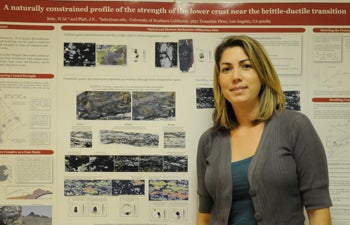Finding Fault
Thorsten Becker, professor of earth sciences, has won a 2013 Friedrich Wilhelm Bessel Research Award, granted by the Alexander von Humboldt Foundation. The award will support his continued research in Potsdam, Germany, on the source of earthquakes and the dynamics of faults.
The geophysicist, USC Dornsife alumnus Thomas Goebel and his colleagues at the GeoForschungsZentrum in Potsdam have been studying acoustic emissions generated by granite put under extreme pressure. By studying when and where cracking sounds in the rock occur before it breaks, their work may help to understand what takes place before and after a large slip event.
“Depending on pressure and temperature, we were able to get the rock to not just fracture but go into a stick-slip cycle where the rock sticks and then it slips along a fault line,” Becker said. “That is what we think is happening for real earthquakes as well.”
In the period between earthquakes, which Becker notes Southern California is currently in, a fault such as the southern San Andreas, is storing energy. Once it snaps, elastic energy — potential energy stored when an object is deformed as in a coiled spring — is released. That’s when the earthquake occurs.
“In theory, we can use studies like this to identify likely places where a rupture might start,” Becker said.
That’s very important information especially in Los Angeles, he noted, because it points to where the strongest ground shaking will occur. For instance, if a rupture goes southward, most of the energy would be radiated into Mexico. If it goes northward, most of the energy would be radiated into the L.A. Basin.
Bessel Award winners are expected to continue to produce cutting-edge research that will have a seminal influence on their discipline beyond their immediate field of work. Candidates must be nominated by two people, either established German academics or former winners of the same award.
The award promotes research collaborations among Germans and the international scientific community. Winners are invited to spend up to one year collaborating on a long-term research project with colleagues at a German research institution.
Becker’s team consists of GeoForschungsZentrum researchers Georg Dresen and Torsten Dahm, as well as USC Dornsife’s Charles Sammis, professor of earth sciences, and Danijel Schorlemmer, adjunct assistant professor (research) of earth sciences. Goebel, who earned his Ph.D. in earth sciences from USC Dornsife in 2013, conducted all of the experiments.
Becker, who joined the USC Dornsife Department of Earth Sciences in 2004, is a member of the planning committee of the Southern California Earthquake Center (SCEC) based at USC Dornsife. He studies geodynamics and seismology with a focus on the interactions among mantle convection, surface geology and Earth’s evolution. In 2007, he was named a Kavli Fellow of the National Academy of Sciences. That same year he received a National Science Foundation CAREER Award. Becker is currently editor-in-chief of the journal Geochemistry, Geophysics, Geosystems.
Becker said he is looking forward to continuing his investigation into what he calls “the earthquake machine,” as well as strengthening ties with the European research community.
“For me, the most fascinating thing about this research is that it is true discovery,” he said. “We’re just taking a rock and breaking it, and out comes a lot of data.”
In other earth sciences department news, the SCEC Community Modeling Environment (CME) Collaboration has won an HPC Innovation Excellence Award. The CME is a collaborative, interdisciplinary research group made up of SCEC researchers who apply advanced computer science technology to the problem of seismic hazard analysis. This award recognizes users and their vendors for major high-performance computing supported achievements in industry, government and academia. Winners are invited to present their success stories at HPC User Forums and other industry events.

Whitney Behr received the 2013 Subaru Outstanding Woman in Science Award from the Geological Society of America. Behr earned her Ph.D. in earth sciences from USC Dornsife in 2011. Here she is during a poster presentation at USC Dornsife in 2010. Photo by Pamela J. Johnson.
Also, Whitney Behr, who earned her Ph.D. in earth sciences in 2011, was awarded the 2013 Subaru Outstanding Woman in Science Award from the Geological Society of America. The annual honor recognizes a woman who has impacted the field of the geosciences based on her Ph.D. research. Behr’s doctoral research focused on structural geology. She studied present-day rock geometries to glean information into its history of deformation or strain. Behr is currently an assistant professor of geological sciences at the University of Texas at Austin.